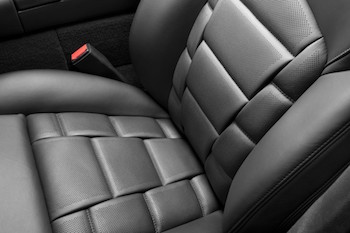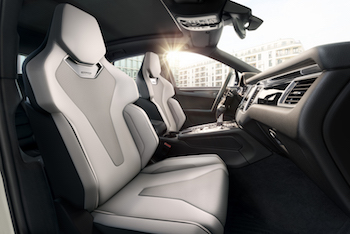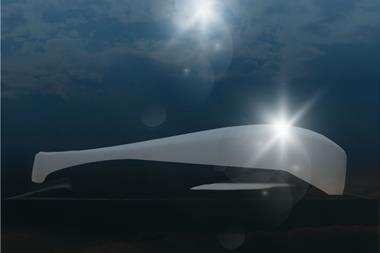Adient CTO Detlef Juerss talks to AMS about the company’s sure and steady approach to new and complex challenges

Among all the exhibits at the IAA international motor show in Frankfurt, a seat that Adient produces for the BMW 7-Series ably exemplifies a modern automotive manufacturing challenge – to combine precision and versatility.
“In theory, you can order one out of 120,000 different versions,” says Dr Detlef Juerss, Adient’s CTO and vice president for engineering. “Seemingly, it’s impossible to manage that supply chain but in fact that’s what we do.”
Spinning off from Johnson Controls in 2016, Adient is continuing in its core competence in automotive seating for all vehicle classes and all major OEMs and into more than 25 million vehicles every year. In other words, Juerss says, supplying of one out of every three car seats installed in vehicles throughout the world.
It takes a great deal of technology to manage that complexity across 230 manufacturing and assembly plants, staffed by 75,000 employees in more than 30 countries. Activities cover research and design all the way to engineering and manufacturing.

Enabling technologiesThe whole topic of design for manufacturing and enabling technologies is something that Juerss believes is not talked about enough: “At the end of the day it is exactly that – there has to be certain enabling technologies in order to make the great new product.”
As the industry prepares for the future of mobility, electrification and the resultant race for lightweighting, Juerss highlights additional considerations.
“The other topics are complexity reduction, on the one hand, but individualisation on the other. What you would think as being two sides of a great divide are actually two sides of the same coin.”
Translating that to manufacturing, Juerss says that Adient wants to deploy standardisation as far along the supply chain as possible. It’s only at the very end of the process that the complexities that the consumer really values are created: the best fabrics, skilled embossings, high-end styling and a designer touch-and-feel.
“Everything downstream is high volume, standardisation with a reduction in complexity. So we’ve got lightweighting technologies, we’ve got supply chain excellence.”
Downstream, Adient is standardising – particularly on metal structures and mechanisms: “We have our JIT complete seat business. It’s basically, the last station in front of the customer, assembling those seats together in one of the many versions, just in time and just in sequence. Usually, we have 90-minute window – we have to build it, ship it, sequence it and sometimes we even have to physically carry it to the line at the customer.”
For Adient’s components manufacturing, the structures and mechanisms standardisation is key in stamping, laser welding, riveting, bolting and so on.
“Manufacturing technology is standardised in order to have the best capital utilisation. We cannot set up a press or weld station for one customer only. We can only have that flexibility if there is manufacturing standardization,” Juerss explains.

"Complexity reduction and individualisation …are actually two sides of the same coin"– Dr Detlef Juerss, Adient
“With our foam business it’s the same thing. Where individualisation comes in is on the trim side. The whole fabric and trim side lives for the complexity. There, operations must be flawlessly executing all of these different variations. That’s where technology comes in.”
The race for lightweighting“We are continuing to excel in the metal structure and tooling technologies. Ultra high strength steels, being able to form them, even 180º on the edges to give that strength and rigidity to the part,” Juerss says.
Juerss cites an example: generation to generation of side members on the backframe. In former times they were 1.2mm and now they measure 0.8mm, with the consequent the weight savings.“That is only possible with state-of-the-art tooling technology that perfectly forms these edges to give you the rigidity. The race for lightweighting is on,” he declares.
The advancements then translates into new designs which are then only achievable using laser welding – driving the joining technologies. Juerss says, “A seat manufacturer or an OEM has to invest in glueing. Otherwise you can’t get an aluminium to stick to a plastic composite or an UHSS. So we are investing in glueing technology. We aren’t saying that the entire seat of the future will be glued together but already today in production, our Recaro branded performance seats are spearheading that kind of technology where we are using composite backshells and glueing them to metal structural components.”
Juerss believes the whole composite topic from the manufacturing side is fascinating. While he doesn’t expect to see significantly higher volumes of composites as the cost is still too high, Juerss recognises strides being made in other areas, such as UHSS: “At Adient we are keeping that race alive. We have an advanced prototype of the next generation Recaro performance seat which uses rim composite technology, braided. It’s a technology that’s also being used for tennis racquets or mountain bike frames. We are not trying that out on the back frame of one of our high performance seats, making it ultra-stiff, ultra-light and by the way it looks very cool.”
New-old technologyWhile new materials are being introduced, there is renewed interest in old ones, too, such as wool. It’s durability and ecological aspects (another driver for new-old technology) have much to offer. However, Juerss admits that to make wool manufacturing capable for an automotive process is a huge effort. Natural materials don’t process as a polyester yarn would, with absolutely consistent.
“In a natural material, fibres are long, short, thick, crimply, in comparison to polyurethane. So there are totally different operational challenges if you want to catch up to a six sigma capability on the process side with a natural material.”
Industry 4.0A JIT plant in Sunderland, UK, is fulfilling a role as Adient’s Industry 4.0 lead plant for structures and mechanisms . However, as Juerss freely concedes, the company doesn’t operate the type of robotised environment synonymous with many settings within automotive manufacturing – but it is on that path.
“There are multiple cornerstones of Industry 4.0. Yes, there’s the idea of big data analysis and feeding it back into design, engineering and production – but we’re not there yet,” Juerss says. For example, to collect end consumer warranty data and flow it back to one piece of equipment or equipment in combination with a given material, cannot be done consistently, Juerss explains: “But we are looking to get there. First, there is the automation of our operations and the predictability of operations inside our four walls. Scrap rates, tied to a certain link of equipment, material, supplier, time period or what have you. That’s the first thing that’s happening.”
“We have a product today that is manually wrapped. It takes a level of craftsmanship to put the seat cover on. So, the first step is to identity when we have this product with fewer wrinkles. What’s the combination, what’s the process and materials that give us fewer wrinkles?”
“The next step is to design a seat that can be trimmed without a human operator. But that’s next generation.”
“So starting with a closed loop inside the plant and then taking it back to consumer data and engineering data. On the engineering side, we are already doing big data analytics. When do development programmes run well, or now well, what are the influences?”
 Adient’s ‘watchstrap’ embossed seat design is one example where automated rather than hand stitching is required in the production process
Adient’s ‘watchstrap’ embossed seat design is one example where automated rather than hand stitching is required in the production processAdjusting positionDespite the steady rather than rapid introduction of smart factory within Adient, Juerss sees that there is an appetite and an incentive to automate.
“Absolutely, there is no industry more competitive and more demanding than the automotive industry. And it’s complicated by the new players coming in and questioning how we’ve operated all these years,” he says.
“If you look at the basics of a seat 50 years ago, it was the same – yes, it was a tube structure, the same kind of mechanism, foam with cloth over it. If we are talking about a design for full automation we would have to rethink from scratch the way an automotive seat will look.”
And that’s what is likely to happen. Tesla has challenged the industry saying, asking why are Adient and its peers designing seats as they did 20 years ago?
While the fundamentals of sitting, comfort requirements, ergonomics haven’t changed, Juerss recognises that translating it into an engineered product that can be capably manufactured in an Industry 4.0 environment is a different story.
For example, Adient is in a co-innovation project with a sports shoe manufacturer on 3D braiding and knitting technologies. The suggestion is, if the technique can be used for a sneaker it will also work for seat trims.
Already in production, Adient’s “watchstrap” seat cover design features an embossed stitching that can only be done by automated stitcher: “It cannot be done by hand because it’s just too complex. So that’s an example of a product that would already show the capacity of doing Industry 4.0 at cut-and-sew,” Juerss explains.
Will there be a big bang making the seats of tomorrow look different? Juerss doesn’t believe so. But he fully anticipates further disruptive technologies alongside established methods. For instance, 3D printing has come a long way – not too far to displace a good metal structure – but Juerss expects one part or another to come the way of 3D printing sooner or later.
 Performance seats now incorporate ultra-stiff, ultra-light rim composite technology akin to that used for tennis racquets or mountain bike frames
Performance seats now incorporate ultra-stiff, ultra-light rim composite technology akin to that used for tennis racquets or mountain bike framesAdient is already looking at 3D printing for foam or plastic parts. Also, one of the products exhibited at the IAA featured a 3D printed frame: “A tubular back frame, 3D printed out of a state-of-the-art metal powder composite. It’s incredible but it takes three days to make so it’s not really production standard. But this part would not have been possible through other metal technology. We used it to question how manufacturing technology can enable design that was previously not achievable.
Juerss is optimistic of progress: “Remember when laser printing began in offices? It was slow and the quality was low. Now it’s different.”
The West Coast players are challenging so much of this, Juerss explains: “They come from the Silicon Valley culture, where next generation software is developed over weeks – not seven years. A totally different mindset.”
“Will the development of seats be faster because we can rely more on simulation and structural analysis? Absolutely. We will go through the same prototype phases as we have for 50 years. We can cut development time by half. That’s where Industry 4.0 will really help.”





































